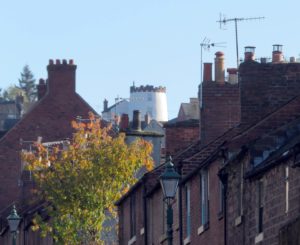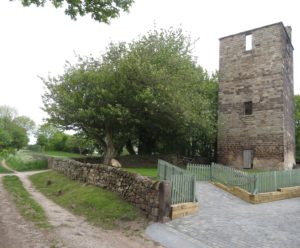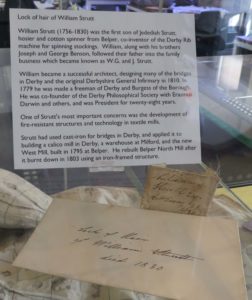Hidden Heritage

Hidden Heritage in the Derwent Valley Mills
When you’ve visited all our main attractions, you may just want to wander around the valley. So, we’re delighted to let you into some secrets here. Now you’ll be able to discover those forgotten treasures and hidden heritage tucked away and read the story behind them.
The Bear Pit
Behind the houses on Cromford Hill, follow a footpath where the Market Place ends and The Hill begins. Here you will happen upon the Bear Pit. No bear has ever been here (that we know of), but it looks the part. It was actually used to control the flow of water to Arkwright’s mills at the bottom of the hill.
Rock House Window
Leawood Pumphouse
Follow the Cromford Canal south from High Peak Junction (or Cromford wharf, if you fancy a longer walk) and you’ll reach Leawood Pumphouse, with its tall chimney. The pumphouse’s massive beam engine still operates on special days. It can pump thousands of tons of water from the river below, to top up the canal, as it has done since 1849.
Wyver Lane Wildlife
North of Belper, and west of the River Derwent, Wyver Lane takes you to a large pond. It sits across the valley from the beautifully laid out Belper Cemetery. Here, you’ll discover plenty of wildlife, particularly water birds, on one of the Derbyshire Wildlife Trust’s most important wetland nature reserves.
Views from the old paths, Belper
The Stone Shield
On Belper Lane, where the road takes a sharp turn to come down the hill for the bridge crossing, the highest house gable on the corner features this stone shield, close to its top point. This is said to be the coat of arms for John O’Gaunt, the son of King Edward III, who once owned Belper and the surrounding countryside. It has been claimed that when the river bridge he had built in the 14th century was swept away by floods in the 1790s, this stone shield was saved from the ruins and re-used here.
The River Gardens Bandstand
Belper Windmill
The Green Bell
Painted on the Christ Church Vicarage, and the old Drill Hall on Cluster Road, both in Belper, you’ll find these green bells and white arrows painted on the buildings. They were luminous markers to help people find the church bells during the wartime blackout. You had to ring the bells if there was an invasion, to warn the town!
Words on a Wall
This plaque on a wall in the Clusters area of Belper is just part of Beth’s Poetry Trail. You can find twenty plaques with appropriate pieces of verse on the Trail which covers much of the town. It’s a lovely Trail to follow and you can find more information at Beth’s Poetry Trail
Railway Bridges
The railway running through the valley from Derby to Ambergate was designed by George Stephenson and his son Robert. It has been described as the best surviving Stephenson-built line in the world. At Belper it passes under eleven bridges, and along a deep cutting. From certain points you can see bridge after bridge after bridge.
The Unitarian Chapel
View from the Parks
The Firing Ranges
Wildersley Farm
There has been a farm at Wildersley – halfway between Belper and Milford on the eastern side of the valley – since Medieval times. It was derelict at one time but has now been restored. Beyond it, further north, is the top of Bessalone Hill, where the Strutts installed an underground reservoir in 1895. It’s well worth a visit on local footpaths, for the fine views across the county.
Milford Footbridge
The Tower
The Wheel Pit
The Abbey
As the name ‘Darley Abbey’ suggests, there was once an abbey on the site of the village. All the buildings from that time have been lost through time, except for this. It is believed to have been the lay-brothers’ refectory. In recent years it has been the Abbey Public House, but is currently closed. It’s still a remarkable survival, and worth a look.
The Fish Pass
William Strutt's Hair
One of the more unusual items to be found in the Derbyshire Record Office at Matlock, relating to the World Heritage Site, is this lock of William Strutt’s hair. William created fireproof iron-framed mills, the forerunner of the modern skyscraper. He was a great inventor and it’s incredible to think this lock of his hair has survived all these years later. He died in 1830.






















